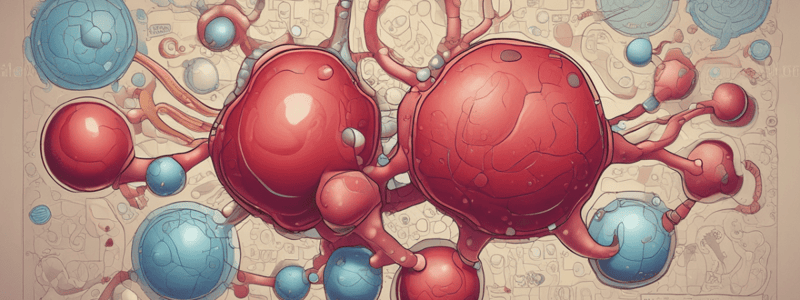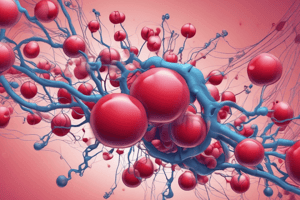Podcast
Questions and Answers
What is the primary function of myoglobin?
What is the primary function of myoglobin?
- Heme iron regulation
- Oxygen transport
- Oxygen storage (correct)
- Carbon monoxide binding
Why is carbon monoxide highly toxic to aerobic organisms?
Why is carbon monoxide highly toxic to aerobic organisms?
- It is a natural component of hemoglobin
- It competes with oxygen for heme binding sites (correct)
- It is a byproduct of oxygen metabolism
- It binds to heme iron with a lower affinity than oxygen
What is the result of oxygen binding to hemoglobin in the R state?
What is the result of oxygen binding to hemoglobin in the R state?
- A structural change in the T state
- A decrease in oxygen affinity
- Release of oxygen in the tissues
- Stabilization of the R state (correct)
What occurs as oxygen is added to hemoglobin?
What occurs as oxygen is added to hemoglobin?
What is the role of the T state in hemoglobin?
What is the role of the T state in hemoglobin?
Why is cooperative oxygen binding important in hemoglobin?
Why is cooperative oxygen binding important in hemoglobin?
What would happen if a protein bound oxygen with high affinity?
What would happen if a protein bound oxygen with high affinity?
What is the advantage of hemoglobin's transition from the T state to the R state?
What is the advantage of hemoglobin's transition from the T state to the R state?
What is the shape of the binding curve of hemoglobin for oxygen?
What is the shape of the binding curve of hemoglobin for oxygen?
What is the effect of the first molecule of O2 binding to deoxyhemoglobin?
What is the effect of the first molecule of O2 binding to deoxyhemoglobin?
What is the term for a protein in which the binding of a ligand to one site affects the binding properties of another site on the same protein?
What is the term for a protein in which the binding of a ligand to one site affects the binding properties of another site on the same protein?
What is the role of O2 in hemoglobin?
What is the role of O2 in hemoglobin?
What is the term for the interaction between a ligand and a protein that affects the binding properties of another site on the same protein?
What is the term for the interaction between a ligand and a protein that affects the binding properties of another site on the same protein?
What is the state of the subunit in which the last molecule of O2 binds?
What is the state of the subunit in which the last molecule of O2 binds?
What two end products of cellular respiration are transported by hemoglobin?
What two end products of cellular respiration are transported by hemoglobin?
What is the significance of the conformational changes that occur upon O2 binding to hemoglobin?
What is the significance of the conformational changes that occur upon O2 binding to hemoglobin?
What is the result of the reaction catalyzed by carbonic anhydrase?
What is the result of the reaction catalyzed by carbonic anhydrase?
What is the primary effect of 2,3-bisphosphoglycerate (BPG) on hemoglobin?
What is the primary effect of 2,3-bisphosphoglycerate (BPG) on hemoglobin?
What is the site of BPG binding to hemoglobin?
What is the site of BPG binding to hemoglobin?
What happens to the BPG concentration in the blood after a few hours at a higher altitude?
What happens to the BPG concentration in the blood after a few hours at a higher altitude?
What is the charge of the amino acid residues lining the BPG binding site?
What is the charge of the amino acid residues lining the BPG binding site?
What percentage of oxygen transport capacity is restored to the tissues at high altitude due to the adjustment in BPG level?
What percentage of oxygen transport capacity is restored to the tissues at high altitude due to the adjustment in BPG level?
What is the primary physiological adaptation of BPG in high-altitude environments?
What is the primary physiological adaptation of BPG in high-altitude environments?
What is the effect of the adjustment in BPG level on the binding of O2 in the lungs?
What is the effect of the adjustment in BPG level on the binding of O2 in the lungs?
What is the percentage of O2 delivered to the tissues in a healthy human at the ocean level?
What is the percentage of O2 delivered to the tissues in a healthy human at the ocean level?
What is the primary reason why fetal hemoglobin must have a greater affinity for oxygen than maternal hemoglobin?
What is the primary reason why fetal hemoglobin must have a greater affinity for oxygen than maternal hemoglobin?
What is the effect of the Bohr Effect on the binding of oxygen to hemoglobin?
What is the effect of the Bohr Effect on the binding of oxygen to hemoglobin?
What type of hemoglobin is synthesized by the fetus, and how does it differ from adult hemoglobin?
What type of hemoglobin is synthesized by the fetus, and how does it differ from adult hemoglobin?
What is the result of the binding of BPG to hemoglobin?
What is the result of the binding of BPG to hemoglobin?
What is the term for the process by which a protein undergoes a conformational change when a ligand binds?
What is the term for the process by which a protein undergoes a conformational change when a ligand binds?
What is the binding site in hemoglobin and myoglobin that binds oxygen?
What is the binding site in hemoglobin and myoglobin that binds oxygen?
What is the effect of 2,3-bisphosphoglycerate on hemoglobin?
What is the effect of 2,3-bisphosphoglycerate on hemoglobin?
What is the shape of the binding curve for oxygen binding to hemoglobin?
What is the shape of the binding curve for oxygen binding to hemoglobin?
What is the ratio of the affinity of CO for free heme molecules compared to O2?
What is the ratio of the affinity of CO for free heme molecules compared to O2?
What type of behavior is exhibited by hemoglobin during oxygen binding?
What type of behavior is exhibited by hemoglobin during oxygen binding?
What is the effect of H+ and CO2 binding to hemoglobin?
What is the effect of H+ and CO2 binding to hemoglobin?
What is the association constant that describes the reversible binding of oxygen to hemoglobin and myoglobin?
What is the association constant that describes the reversible binding of oxygen to hemoglobin and myoglobin?
What is the effect of oxygen binding on the structure of hemoglobin?
What is the effect of oxygen binding on the structure of hemoglobin?
What is the ratio of the affinity of CO for heme molecules bound in hemoglobin compared to O2?
What is the ratio of the affinity of CO for heme molecules bound in hemoglobin compared to O2?
Why does carbon monoxide bind more strongly to free heme molecules than to heme molecules bound in hemoglobin?
Why does carbon monoxide bind more strongly to free heme molecules than to heme molecules bound in hemoglobin?
Flashcards are hidden until you start studying
Study Notes
Oxygen Binding to Hemoglobin and Myoglobin
- Myoglobin has only one subunit and is relatively insensitive to small changes in the concentration of dissolved oxygen, making it suitable as an oxygen-storage protein.
- Hemoglobin, with its multiple subunits and O2-binding sites, is highly sensitive to small changes in ligand concentration, making it better suited for oxygen transport.
Why CO is Highly Toxic to Aerobic Organisms
- Carbon monoxide (CO) binds to heme iron with greater affinity than O2, excluding O2 and making it highly toxic to aerobic organisms.
- CO binds to heme 200 times better than O2.
Hemoglobin Conformations
- Hemoglobin undergoes a structural change on binding oxygen, with two major conformations: the R state and the T state.
- Oxygen binding stabilizes the R state, which has a higher affinity for O2 than the T state.
- T state is the predominant conformation of deoxy Hb, with O2 binding stabilizing the R state.
Cooperativity of Hemoglobin-O2 Binding
- Hemoglobin binds oxygen cooperatively, with a transition from a low-affinity state (T state) to a high-affinity state (R state) as more O2 molecules are bound.
- This results in a hybrid S-shaped, or sigmoid, binding curve for oxygen.
Allosteric Protein and Homotropic Interaction
- Hemoglobin is an allosteric protein, where the binding of a ligand to one site affects the binding properties of another site on the same protein.
- Homotropic interaction occurs when the ligand acts as a modulator, with O2 both a normal ligand and an activating homotropic modulator for Hb.
Hemoglobin Transport of H+ and CO2
- Hemoglobin carries two end products of cellular respiration, H+ and CO2, from the tissues to the lungs and kidneys, where they are excreted.
- CO2 is hydrated to form bicarbonate: CO2 + H2O → H+ + HCO3-.
Bohr Effect
- The Bohr effect is the effect of pH and CO2 concentration on the binding and release of oxygen by hemoglobin.
Regulation of O2 Binding to Hemoglobin by 2,3-BPG
- Hemoglobin also transports 2,3-bisphosphoglycerate (BPG), which regulates O2 binding to hemoglobin.
- BPG binds to hemoglobin, reducing its affinity for O2, and is important in physiological adaptation to high altitudes.
- In fetal development, BPG has a critical role in regulating O2 binding to hemoglobin.
Fetal Hemoglobin
- Fetal hemoglobin must have a greater affinity for O2 than maternal hemoglobin because the fetus must extract O2 from its mother's blood.
- The fetus synthesizes γ subunits rather than β subunits, forming α2γ2 hemoglobin, which has a lower affinity for BPG and a higher affinity for O2.
Studying That Suits You
Use AI to generate personalized quizzes and flashcards to suit your learning preferences.



